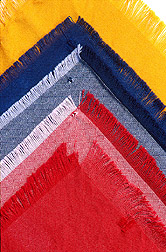|

Read:
additional information about this research in Agricultural
Research. |
Wool and Cotton Can Now Dye Together
By Tara
Weaver-Missick November 9, 2000
A process to make cotton more chemically similar to wool so the two
fibers can be combined into an easily dyed fabric blend has been developed by
Agricultural Research Service chemists.
Scientists at ARS’ Eastern
Regional Research Center in Wyndmoor, Pa., developed the new single-bath
dyeing procedure, called union dyeing, for wool/cotton blends. Normally, when
wool and cotton are blended together, two separate dye baths are required.
Before the new process was developed, dyeing a cotton/wool blend was
difficult because the two fibers have different chemical makeups, leading to
uneven coloring. Wool takes up most of the dye, while the cotton is left mostly
undyed.
ARS’ simple approach is to reverse the chemical charge of cotton
from negative to positive before dyeing so that both fabrics are positively
charged. Wool is already positive. The scientists use positively charged
compounds called cationic fixatives, which are typically applied after cotton
is dyed to help it retain color.
Since the dye is negatively charged and opposites attract, the cotton
and wool dye to a uniform shade because the dye is attracted equally to both
fibers. This one-step union-dyeing process can be done with one dye, in one
bath, under one set of conditions.
Experimental textile treatments like this one may broaden the market
for cool-weather garments made of wool and cotton blends. This technology could
cut textile dyeing costs, savings that can be passed to consumers seeking
versatile garments for both the spring and fall months.
Additional information about this research is available in the
November issue of ARS' Agricultural
Research magazine.
ARS is the chief scientific research agency of the
U.S. Department of Agriculture.
Scientific contacts: William N. Marmer and Jeanette M.
Cardamone, Hides, Lipids and Wool Research Unit, ARS Eastern Regional Research
Center, Wyndmoor, Pa.; phone (215) 233- 6585 [Marmer], (215) 233-6680
[Cardamone]; fax (215) 233-6795; wmarmer@arserrc.gov,
jcardamone@arserrc.gov.